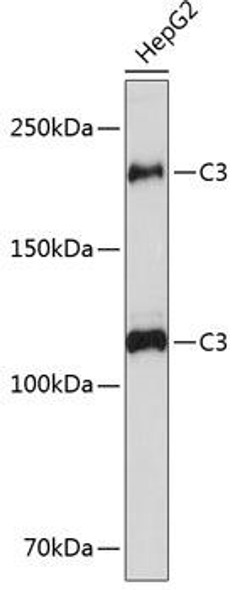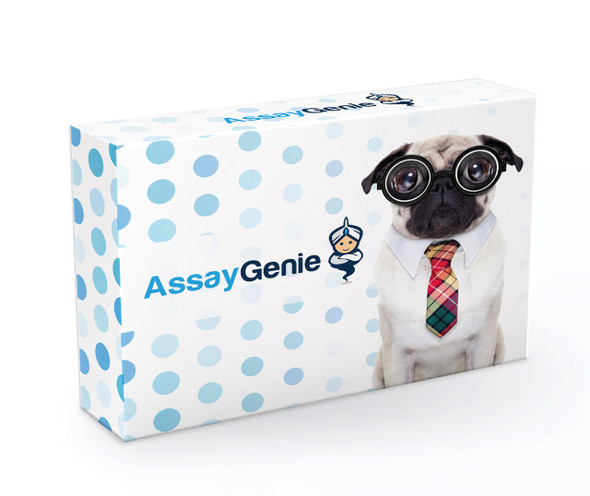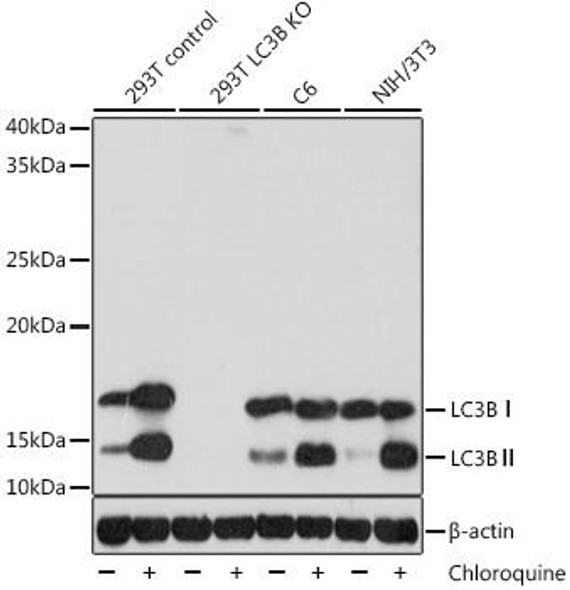Description
| Product Name: | C3/C3b/iC3b monoclonal antibody |
| Product Code: | AGIM0007 |
| Size: | 100 µg in 100 µL |
| Reactivity: | Human |
| Clone: | 6C9 |
| Applications: | Flow Cytometry |
| Conjugate: | Unconjugated |
| Isotype: | IgG1 |
| Host Species: | Mouse |
| Storage: | Store at 4°C. For long-term aliquot and store at 20°C. Avoid freeze/thaw cycles. |
| Uniprot: | P01024 |
| UniProt Protein Function: | C3: C3 plays a central role in the activation of the complement system. Its processing by C3 convertase is the central reaction in both classical and alternative complement pathways. After activation C3b can bind covalently, via its reactive thioester, to cell surface carbohydrates or immune aggregates. Defects in C3 are the cause of complement component 3 deficiency (C3D). A rare defect of the complement classical pathway. Patients develop recurrent, severe, pyogenic infections because of ineffective opsonization of pathogens. Some patients may also develop autoimmune disorders, such as arthralgia and vasculitic rashes, lupus-like syndrome and membranoproliferative glomerulonephritis. Genetic variation in C3 is associated with susceptibility to age-related macular degeneration type 9 (ARMD9). ARMD is a multifactorial eye disease and the most common cause of irreversible vision loss in the developed world. In most patients, the disease is manifest as ophthalmoscopically visible yellowish accumulations of protein and lipid that lie beneath the retinal pigment epithelium and within an elastin- containing structure known as Bruch membrane. Defects in C3 are a cause of susceptibility to hemolytic uremic syndrome atypical type 5 (AHUS5). An atypical form of hemolytic uremic syndrome. It is a complex genetic disease characterized by microangiopathic hemolytic anemia, thrombocytopenia, renal failure and absence of episodes of enterocolitis and diarrhea. In contrast to typical hemolytic uremic syndrome, atypical forms have a poorer prognosis, with higher death rates and frequent progression to end-stage renal disease. Susceptibility to the development of atypical hemolytic uremic syndrome can be conferred by mutations in various components of or regulatory factors in the complement cascade system. Other genes may play a role in modifying the phenotype. Increased levels of C3 and its cleavage product ASP, are associated with obesity, diabetes and coronary heart disease. Short-term endurance training reduces baseline ASP levels and subsequently fat storage. |
| UniProt Protein Details: | Protein type:Secreted, signal peptide; Inhibitor; Secreted Chromosomal Location of Human Ortholog: 19p13.3-p13.2 Cellular Component: extracellular space; extracellular region; plasma membrane Molecular Function:protein binding; endopeptidase inhibitor activity; C5L2 anaphylatoxin chemotactic receptor binding; receptor binding Biological Process: regulation of immune response; complement activation, alternative pathway; signal transduction; fatty acid metabolic process; complement activation; G-protein coupled receptor protein signaling pathway; positive regulation of angiogenesis; positive regulation of activation of membrane attack complex; positive regulation of type IIa hypersensitivity; positive regulation of G-protein coupled receptor protein signaling pathway; regulation of complement activation; innate immune response; immune response; positive regulation of protein amino acid phosphorylation; inflammatory response; complement activation, classical pathway Disease: Complement Component 3 Deficiency, Autosomal Recessive; Hemolytic Uremic Syndrome, Atypical, Susceptibility To, 5; Macular Degeneration, Age-related, 9 |
| NCBI Summary: | Complement component C3 plays a central role in the activation of complement system. Its activation is required for both classical and alternative complement activation pathways. A peptide (C3a) derived from the encoded protein has antimicrobial activity, so people with C3 deficiency are susceptible to bacterial infection. [provided by RefSeq, Nov 2014] |
| UniProt Code: | P01024 |
| NCBI GenInfo Identifier: | 119370332 |
| NCBI Gene ID: | 718 |
| NCBI Accession: | P01024.2 |
| UniProt Secondary Accession: | P01024,A7E236, |
| UniProt Related Accession: | P01024 |
| Molecular Weight: | |
| NCBI Full Name: | Complement C3 |
| NCBI Synonym Full Names: | complement component 3 |
| NCBI Official Symbol: | C3 |
| NCBI Official Synonym Symbols: | ASP; C3a; C3b; AHUS5; ARMD9; CPAMD1; HEL-S-62p |
| NCBI Protein Information: | complement C3; prepro-C3; C3a anaphylatoxin; complement component C3; complement component C3a; complement component C3b; acylation-stimulating protein cleavage product; epididymis secretory sperm binding protein Li 62p; C3 and PZP-like alpha-2-macroglobulin domain-containing protein 1 |
| UniProt Protein Name: | Complement C3 |
| UniProt Synonym Protein Names: | C3 and PZP-like alpha-2-macroglobulin domain-containing protein 1Cleaved into the following 12 chains:Complement C3 beta chain; C3-beta-c; C3bc; Complement C3 alpha chain; C3a anaphylatoxin; Acylation stimulating protein; ASPAlternative name(s):C3adesArg |
| Protein Family: | Complement C3 |
| UniProt Gene Name: | C3 |
| UniProt Entry Name: | CO3_HUMAN |









